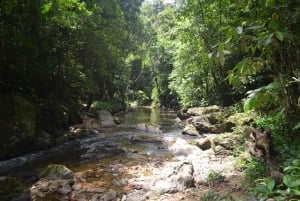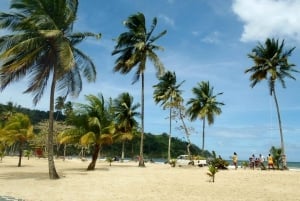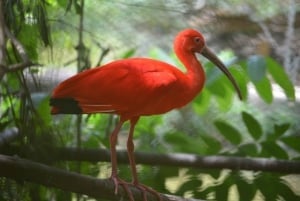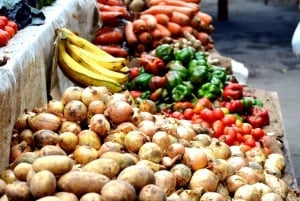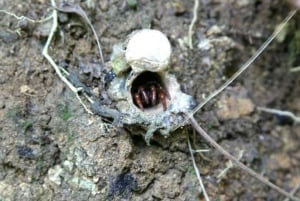History
Trinidad and Tobago’s history can best be described as a melting pot of cultures, waring nations and abundant natural wealth. These two islands share a unique history with influences from all the people who came and stayed. Amerindian, African, Asian, and European cultures have mixed together in the Caribbean heat to create that perfect Trinbagonian stew.
Pre Colonial
Trinidad was first settled by pre-Columbian peoples at least 7,000 years ago, making it the earliest-settled part of the Caribbean. It was on his third voyage that Christopher Columbus stumbled upon the island on 31 July 1498 and claimed the it for Spain. He named it La Trinidad, in honor of the Blessed Trinity. For three decades Spain showed little interest in the islands.
Columbus found the island inhabited by the Aruacas or Arawaks a peaceful Amerindian tribe originating from Guyana and Caribs the more warlike tribe with origins stemming from the Amazon region. The Arawaks settled mostly in the south of the island and were an agricultural society growing crops such as cassava, sweet potato and maize. To the north of the island the fiercer Caribs who were reputed to be cannibals, fiercely fought with the Arawaks and later against various European attempts to colonize the islands.
Years of enslavement, coupled with new diseases brought to by the European colonizers took their toll on the Amerindian tribes resulting in the eventual decimation of the indigenous population.
Colonial Rule
The next century saw several European nations making attempts at colonizing Trinidad with little success. Short stints of colonization were done by the Dutch and British but it wasn't until the end of the 18th century, when the Spanish King, issued the historic Cedula of Population that the rapid colonization of Trinidad began. The Cedula issued free grants of land to Roman Catholic citizens of any land friendly to Spain. This meant most of the new settlers were French, since Spain's other ally at the time, England was predominantly Protestant.
Between 1783 and 1789 there was population of boom in Trinidad. In those six years the local population rose from 2,700 inhabitants to 17,700 a staggering 10,000 of whom were African slaves. This was because the Cedula provided additional grants of land to slave owners for each slave. At this time there was an influx of French planters and free persons of color from the French colonies intent on capitalizing on the land grants. Over time French-based patois became the main language spoken on the island.
Spain’s strong hold on Trinidad ended in 1797, when the British, who were no longer their allies attacked Trinidad and seized control of the island. Trinidad hence forth would be a British colony until its independence in 1962.
British Rule
With its main exports being cocoa and sugar Trinidad and Tobago’s plantocracy depended heavily on cheap slave labour. So with the abolition of slavery by the British Parliament on August 1, 1834, a new system of cheap labour had to be implemented. British Parliament mandated that ex-slaves were required to give a predetermined period of apprenticeship to their former owners. This was met with protests and demonstrations by the ex slaves and on August 1, 1838, the Governor of the island relented and nullified the apprenticeship system in Trinidad.
Realizing that a replacement labour force would have to be sourced after the failure that was apprenticeship, Trinidad's planter lead Council of Government, appointed an Agent for Immigration to source alternative field labour. Irish, Portuguese, Chinese and free Africans were brought to the island with little or no longevity or success as field laborers.
The ideal labour force was eventually found on the continent of India and on May 30, 1845, the first boatload of 213 indentured laborers arrived aboard the Fatel Rozack. Over the years there was a steady flow of immigration to the island and by the time the Indian government banned emigration to Trinidad in 1917 the number of indentured workers from had risen to more than 145,000.
Discovery of Oil
A little know fact is that the first oil well drilled in the world was drilled in 1857 in Southern Trinidad. However it was not until some 50 years later that an industry could be built on the island. Trinidad’s first 25,000 barrels of crude oil were exported in 1923 and oil exports for the first time exceeded those of sugar and cocoa combined. By 1936, the island had become the lead producer of oil in the British colonies.
Oil Boom
Trinidad and Tobago profited greatly from the 1972 to 1983 with the rising price of oil, the nations standard of living increased exponentially. As more foreign investors laid stakes in the nations lucrative oil industry a frustrated population, specifically oil field workers perceived this as a second colonization by way of economic control. The riots, protests and attempted coup of 1970 stemmed from these frustrations.
The country entered a second oil boom in 2003 and although it was predicted that this boom would last only 15 years, Petroleum, petrochemicals and natural gas remains the driving force behind Trinidad’s economy. While Tobago relies mainly on tourism as its main income generator.
Thanks to its oil revenue the country enjoys a stable democracy and has the highest standard of living of its Caribbean counterparts.
Independence
Rising pressures from the workers Trade Unions and cries from citizens for control of their collective destiny, pushed Trinidad towards attaining partial self-governance in 1925. Years later on August 31, 1962, Trinidad and Tobago finally gained independence after 165 years of British rule.
Fourteen years later in 1976 the nation severed ties with the British Monarchy and became a Republic within the Commonwealth.
Political System
Trinidad and Tobago follows the Westminster system it inherited from the United Kingdom. The Prime Minister along with his cabinet is voted in by a national election and are entrusted with the daily running of the country. Every 5 years the country has general elections and legislative power lies with the House of Representatives. Administration and the implementation of governments policies in Tobago is done by the elected Tobago House of Assembly and all issues on the island are reported back to the cabinet.
The democratic electoral process is relatively smooth but affiliations tend to lean towards race. The two main political parties are the People National Movement (PNM) and the United National Congress (UNC). Other parties include Congress of the People (COP), Democratic Action Congress (DAC) active in Tobago, Democratic National Alliance (DNA), Movement for National Development (MND), National Alliance for Reconstruction (NAR), Tobago Organization of the People (TOP) active in Tobago.
Religion
Under the Spanish, Roman Catholicism was the official religion, and it was strengthened by French immigration during the French and Haitian revolutions. Anglicanism and Protestantism gained a foothold in various forms with the advent of the British. People from the Indian subcontinent brought with them their languages and their Hindu and Muslim religions. Both Sunni and Shiite Muslim groups are present.
Further diversification followed with the immigration of Syrians and Lebanese. African-influenced religious sects include the Shango, or Orisha, faith, derived from the Yoruba culture of modern Nigeria, and the Spiritual Baptists, a syncretic Protestant-African church. In the late 20th century there was a striking increase in the adherents of Hinduism and of various fundamentalist, Evangelical, or Pentecostal churches, mainly of U.S. origin.


